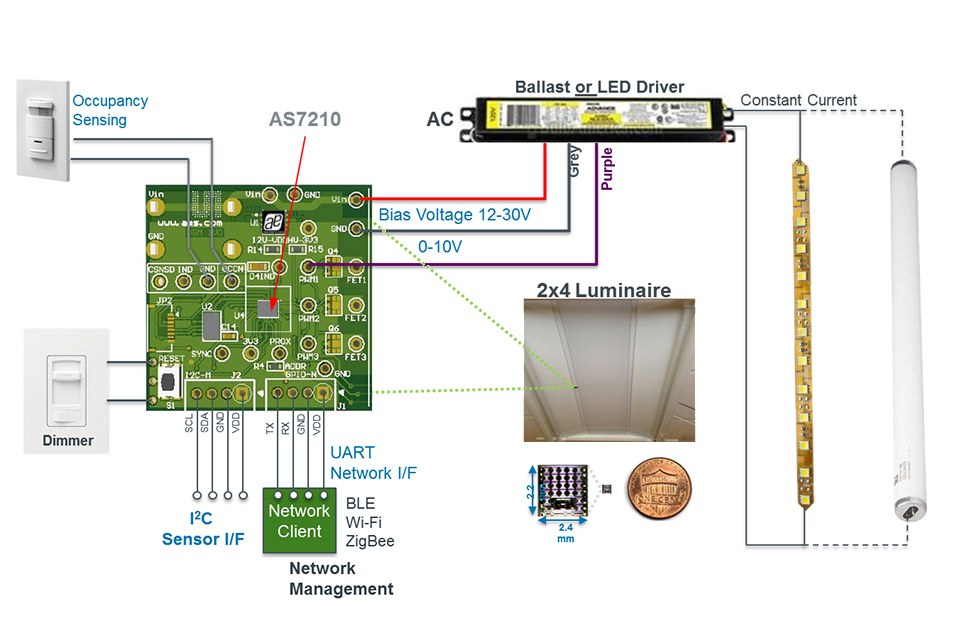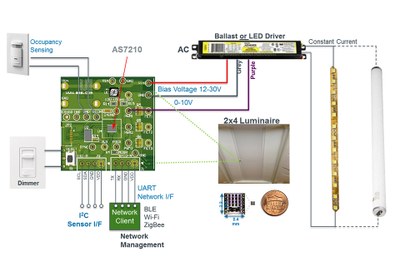ams Combines Daylight Sensor and Smart Lighting Manager to a Compact IoT-Hub
ams AG, a leading provider of high performance analog ICs and sensors, today introduced its revolutionary AS721x Autonomous Daylighting Manager, the industry’s first integrated chip-scale Internet of Things (IoT)-connected smart lighting manager. This new class of sensor-integrated smart lighting manager solutions delivers cost-effective, IoT-connected integrated control capabilities to luminaire, light engine and replacement lamp manufacturers. A Smart Lighting Integration Kit (SLIK) allows for an easy and quick implementation.
Attributes of the ams’ AS721x Autonomous Daylighting Manager:
• 20-pin 2.1 x 2.3mm chip-scale and 4.5 x 4.7mm land grid array package options
• Photopic daylighting sensor for accurate ambient light sensing and control
• Integrates with industry standard 0-10V controls, driving 0-10V and multi-channel PWM outputs
• Standard serial UART (AS7211) for expansion to any standard networking or integrated IR remote control decoding (AS7210)
• Network-enabled architecture with a high-level, driverless smart lighting command set for IoT connectivity via Bluetooth 4.x (BLE) , ZigBee, WiFi, Ethernet/PoE or other networks
• I2C sensor expansion creating lighting-hosted sensor-bridge capabilities
Photopic sensors built with nano-optic filters integrated into the AS721x series are designed to help lighting manufacturers address the growing challenges of energy-saving lighting mandates, including daylighting controls. These challenges are more cost-effectively met by bringing the controls and high-granularity sensing into the luminaires themselves.
The AS721x family is ams’ first platform technology of integrated sensor solutions that provide system-level sensing and control capabilities, greatly reducing system costs and shortening time-to-market. The AS721x Autonomous Daylighting Manager senses the ambient daylight and enables the delivery of constant lux levels in the space by managing subtle adjustments as the amount of outside light varies. Integrating a sensor-based manager into each luminaire optimizes the overall responsiveness and efficiency of the lighting system, maximizing energy savings. The approach also delivers accurate lumen maintenance over time and temperature variations, and allows fully connected luminaire systems to respond to building- or space-level command and control strategies.
Competitive offerings in the space are essentially “build your own” devices requiring discrete components, including sensors, processors, memory, and I/O chips, that require design, integration and time-consuming programming of control and communications algorithms. In contrast, the AS721x family delivers a fully integrated solution, providing users with a high level of integration at far lower cost and complexity than using discrete components.“ams’ ground-breaking sensor-integrated manager series addresses head-on the lighting industry’s desire for technically feasible integrated controls that are also cost- and space-effective. It’s a solution that will truly revolutionize the lighting industry, and deliver the kind of network-connected system approach that exemplifies the power of the Internet of Things,” said Brian Bedrosian, Senior Director, Product Marketing of Broadcom, which is providing Bluetooth Low Energy (BLE) Smart connectivity for the IoT-connected AS721x series.
In an exclusive presentation for LED professional, Sajol Ghoshal disclosed some background information and talked about ams’ intentions when they designed this product:
´“The AS721x family is an industry-first platform technology which combines nano-optic sensor-integration with an IoT-connected sensor solution,” said Sajol Ghoshal, responsible for Emerging Sensor Strategies at ams. “The convergence of integrated lighting controls, sensor fusion and wireless connectivity enables the creation of the Internet of Awareness for IoT-connected lighting systems, positioning them as natural sensor hubs within built spaces.”
“ams recognized a trend of integrating more and more sensors in building environments. In some areas, like California, there are regulations effective that require sensors that measure CO and CO2 in residential units,” he explained. “Furthermore, there is a clear trend towards cloud operated systems and IoT. As a consequence, building infrastructure in the future needs to be IoT based. Lighting equipment is usually installed in an ideal position so that it can act as the IoT hub.”
ams also sees additional advantages and opportunities of IoT based installations, which go far beyond standard building infrastructure. Healthcare and the care of the elderly are just two examples. For this reason the AS721x is designed to support any type of IoT sensor or communication and not just ams sensor products. ams also recognized the shift of transferring intelligence via an app to smart phones or tablets. This makes sensor-based controls more affordable than ever before. The integration of sensors in silicon and the resulting miniaturization allows for an almost invisible application of sensors in many products, especially luminaires. Mr. Ghoshal is convinced that “…luminaires will soon be acting as sensors and IoT hubs due to the lower costs. In the future every luminaire may be equipped with its own sensor.”
A Smart Lighting Integration Kit (SLIK), shown in the image, is also offered by ams. According to Sajol Ghoshal, the starter kit makes installation simple. There are some very interesting features shown in the images that LED professional discussed with Mr. Ghoshal in more detail. One was the 1” x 1” board that includes the most important features and interfaces for setting up a complete IoT environment. ams designed the AS721x series to make communication simple, which includes a command set for lighting. The concept offers an administrator level as well as a user level. This allows the action of the AS721x node to be pre-defined within the entire infrastructure. The same hardware can be easily configured to give users different options, depending on the application or location. In an office, users could be allowed to completely override settings for their personal luminaire with the dimmer input, whereby in class rooms this option would be limited to a certain level or completely limited in places like corridors.
The dimmer input is a very interesting feature, especially for residential applications. As with all LED systems there are two questions that come up. The first is about dimmer compatibility. Mr. Ghoshal’s answer to that made perfect sense when he explained, “The interesting part of this design is that it works with any phase-cut dimmer. The reason is that the phase-cut dimmer resides at the AC input and fundamentally adjusts the constant current that the LED driver delivers.” When we asked how the input is interpreted and about the resulting dimming curve, he said, “The in/out dimming curve is selectable by the user as linear or logarithmic (DALI style). However, ams engineered the device so that dimming adjustments are made in steps that are imperceptible to the human eye while following these curves and while changing the light intensity in a reasonably fast timeframe so the user is not left waiting for the intensity of the light to change.”
Time dependent programs and scenes can be set easily. It is also very important to be able to update the software, which can be done without interrupting normal operation.
The current IC configurations offer three PWM channels that can be used for RGB control or as single outputs for three independent drivers and an integrated daylight sensor. In answer to the question of how to support full CCT control with sophisticated multicolor systems, Mr. Ghoshal said, “We started with the IC configuration that we expected to be the most important and most requested for a very competitive price, but we already have even more sophisticated configurations in mind, including color sensors and additional PWM channels that will support high end solutions with accurate CCT control that don’t only provide a constant illumination level in daylight harvesting tasks, but also CCT adaptation.”
Pricing and ordering Information:
Pricing for the AS721x Autonomous Daylighting Manager family is less than $3 in quantities of 5,000 pieces. Selected high-volume customers are testing sampled devices now, with production devices available in Q3 2015. Contact Thomas.Griffiths@ams.com for product details.
About ams:
ams is a global leader in both the design and manufacture of advanced analog sensor solutions. Our mission is to shape the world with sensor solutions and take sensing to the next level by providing a seamless interface between humans and technology. ams’ high-performance analog products fuel applications requiring extreme precision, dynamic range, sensitivity, and ultra-low power consumption. Products include sensors, sensor interfaces, power management and wireless ICs for computer, consumer, communications, industrial, medical, and automotive markets.
With headquarters in Austria, ams employs over 1,600 people globally and serves more than 7,800 customers worldwide. ams is listed on the SIX Swiss stock exchange (ticker symbol: AMS). More information about ams can be found at www.ams.com.


